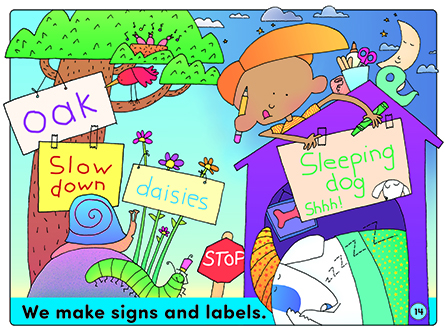Additional Activities
These activities offer options for continuing the learning in this unit. Whether your curriculum is skill-based or more open-ended, select the activities that are most appropriate for the children in your classroom. The Writing Spot is primarily a writing program, but writing can be integrated throughout your curriculum—in art, drama, reading, math, and science.
-
Decorate signs that say, “My Place.”
Have children design a sign to designate their own special place at school or at home. Allow them to creatively decorate their signs. The signs can be put on a desk, a cubby, or a bedroom or closet door at home, and so on. Use "My Place" for this activity.
-
Post signs to say, “Hello.”
Explain that many stores have signs on their doors to greet people. Greeting words include “welcome,” “hello,” “enter,” and “come in.” Have children make decorated signs that include these words. Get permission from local store owners for students to display their signs in the store windows, offering students a sense of accomplishment and a positive tie to the community. Use "My Greeting Sign" for this activity.
-
Create computer-generated signs.
If they are available, use computers and software to create signs. Simple software for making signs and banners is available at most bookstores, at department stores, and on the Internet.
Make some large laminated signs designating the different ways children are transported to school—signs in the shape of a bus, a car, and a shoe. Invite children to write their names with an erasable marker or a grease pencil on the correct sign for their situation. If there are multiple buses, write the bus number or letter next to individuals’ names. (Make other signs as needed.)
-
Produce tickets for class events.
Whenever your class prepares a “presentation” of any kind, encourage them to make their own tickets for the event.
-
Play a game with signs that tell you what to do.
Have children make signs that tell the class what to do. They may make signs with pictures and simple words like “jump,” “sit,” or “stand.” Then have the children take turns showing their signs to the class. If the class understands the message, they should respond by doing whatever the sign says.
-
Share “international” picture-only signs.
Explain that it is very important for people to understand signs. Share picture-only signs with your class. Examples:

Have students guess what the pictures mean. Then ask them to make their own picture-only signs.
-
Make signs for an obstacle course.
When children need to expend some energy, create an obstacle course in the classroom or on the playground by placing directional signs in various locations. Use words like “in,” “out,” “around,” “through,” “under,” “enter,” “exit.” (If it is feasible, let the children help by copying words onto the signs.) Have the children follow the signs to complete the course. Then plan a new obstacle course, with the students’ help, by moving the signs. They may add some new signs if they wish.
-
Put up signs that label things.
Each day, put a label on something for the children to find in the classroom. You may want to color-code the new labels so they are not confused with other standard labels in the room. Some of these labels should represent “new words” for the children. You may label things already in the classroom or bring in some new items. Don’t make the labels too obvious. Part of the fun is looking for them.
-
Design signs about staying safe.
Have a class discussion about safety. Show some familiar examples of safety signs: a stoplight, a stop sign, a no swimming sign, walk and don’t walk signs. Ask children where they have seen safety signs. Ask them where they think safety signs may be needed and why. Have children create their own safety signs.
Talk about signs that announce events: a store sale, garage sale, bake sale, school concert, or play. Show example posters that tell about an event, where it is happening, and when. Have the children make poster signs for their own imaginary sale. They should draw the item that they would like to sell and include the words “For Sale” on the poster. (You may also provide papers with the words “For Sale” already printed in large letters on the top or bottom of the page.)
-
Produce signs that say, “Lost and Found.”
Tell children that signs are useful for helping people find lost things. Have them make signs that tell about a pretend lost pet. At the top of their signs, children should write, “Lost (kind of animal).” In the middle, they should draw or paste on a picture of a pet they wish they had. At the bottom, they should write, “Call (child’s name).” Include a made-up phone number under the child’s name. Put these posters in a special display.


